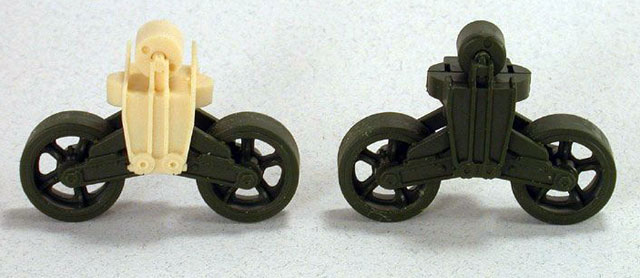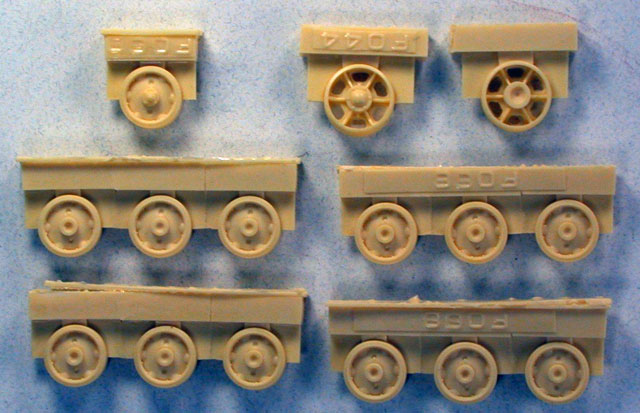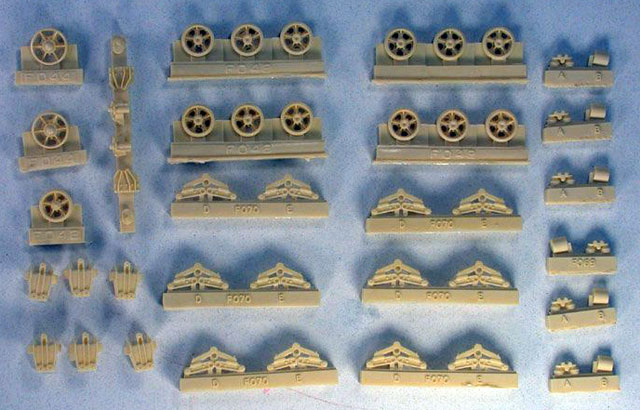|
|
|
|
|
Home >
Reviews >
USA > Formations
Models F068 M3 Lee Solid Stamped Road Wheels F069 Quick Fix Suspension Set for Academy’s M3 Lee F070 M3 Lee Style Suspension Set |
Formations Models
F068 M3 Lee Solid Stamped Road Wheels
F069 Quick Fix Suspension Set for Academy’s M3 Lee
F070 M3 Lee Style Suspension Set
Reviewed by Neil Stokes
Summary
|
Stock Number and Description |
Formations Models F068 M3 Lee Solid Stamped Road Wheels |
|
Scale: |
1/35 |
|
Media and Contents: |
15 resin parts (F068)12 resin parts and one length of styrene rod (F069)63 resin parts and one length of styrene rod (F070) |
|
Price: |
USD$11.00 (F068) |
|
Review Type: |
First Look |
|
Advantages: |
Nicely engineered update sets that integrate easily with Academy kit parts (F068 & F069) or your favorite M4 lower hull (F070) |
|
Disadvantages: |
Somewhat fragile details require careful cleanup and assembly |
|
Recommendation: |
Highly Recommended to modelers with moderate experience |
FirstLook
Academy’s M3 Lee has been available for some months now. While it is a very nice kit with a wealth of detail, there are some well-publicized detail discrepancies that the fastidious will wish to correct.
Most of these issues can be corrected with patience and some styrene, but one of the more difficult problems is the dimensional error in the Academy kit’s VVSS bogie housings. According to a number of sources including Steve Zaloga’s posts to Missing-Lynx, the bogie housings are approximately 2mm too tall. In order to keep the overall dimensions of the suspension correct without affecting the ride height of the vehicle, Academy shortened the mounting arms for the return rollers. The result is something that looks almost, but not quite like an M3 bogie.
Apparently, the discrepancy arose from Academy’s desire to use the volute spring part from their earlier M4 suspension set. The M4 springs were larger than the M3 springs, and their efforts to accommodate the larger part led to the “mutated” bogie housing.
To be fair to Academy, the bogies do not look too bad and at first glance the discrepancy is not all that noticeable. However, when you compare the bogies to photographs, it is easy to see the difference. Take a look at the photographs accompanying this review, and see what I mean.
There are a number of approaches to dealing with this problem. You can whine about it (most of us started there), you can perform some complicated and tedious surgery on the kit parts (make sure you get all six of them identical, now) or you can go looking for an after-market remedy.
The Formations Update Sets
Into the breach (not the breech) steps Rob Ervin from Formations. The master of all things M4 has learned to subtract 1 and turned his attention to the M3. Formations have released the first two sets to correct and augment the parts in the Academy kit, along with a separate set of M3 suspension.
Set F068 provides a full set of stamped (or “pressed” if you prefer) road wheels, along with a spare road wheel and two welded idlers. These wheels allow you to correctly depict one of the many M3s fitted with these wheels in the North African campaign.
Set F069 provides a full set of corrected bogie housings including correctly sized volute springs and return rollers.
Set F070 provides a complete M3 suspension set including the contents of F069 plus swing arms, open spoked wheels and idlers, and a set of adjustable idler mounts.
F069 Quick Fix Set for Academy’s M3 Lee

Click the thumbnails below to view larger images:
Let’s start with the bogies. Each bogie is comprised of three resin parts (the bogie housing, the volute springs and the return roller) which, when combined with the swing arms and road wheels from the Academy kit, make up the complete bogie.
I compared the parts with the drawings on p51 of Hunnicutt’s Sherman book, and they scale out well, based on the accuracy limits of my ruler, eyeball and calculator (the drawings are to 1:48 scale). Perhaps more importantly, the finished bogie looks right.
The bogie housing is cast as a single part, and requires some minor cleanup around the lower edges; nothing that a few careful swipes with a hobby knife or a file cannot fix. You must remove some flash from the cut-outs in the reinforcing brackets on top of the housing, and this is called out in the instructions.
These brackets are quite delicate, which is nice but means that they require some careful cleanup. Thankfully the resin that Formations uses is somewhat flexible so the brackets are a little forgiving of some rough handling. I recommend cleaning the flash from the lower bogie housing first, then using a sharp #11 blade to clean out the cut-outs. Be careful of the two bolt heads on the top of the bogie housing. I nearly removed one, thinking it was a casting imperfection.
A locating pin is cast into the rear of the bogie housing and mates with the locating hole in the side of the Academy hull. This should provide a sufficiently strong join with cyanoacrylate, but you may wish to use epoxy if you have a particularly cautious nature.
The two volute springs for each bogie are cast as a single part, and even include the ends of the wound springs. The springs, along with the return roller, are cast on a substantial pour plug, but the attachment point is on the top of the spring which makes it invisible when the parts are assembled.
The return roller is cast as a separate part on the same pour plug. The rear (inner) mounting arm is cast integrally with the return roller, while the front (outer) arm is cast integrally with the bogie housing. This makes for a nice visible separation on the most visible part of the return roller while reducing the number of parts and thereby simplifying the construction.
The rear mounting arm is cast a little too long, and will require some filing to make the return roller sit parallel to the top of the bogie housing. I suspect that this is a deliberate move since it allows for some shrinkage in the resin and avoids the risk of the part being too short when you go to attach it to the bogie housing.
The set uses the swing arms and road wheels from the Academy kit. After cleaning up the styrene parts, fit the wheels to the swing arms and cement the two swing arms together. When the joint is set, slip the resin bogie housing over the swing arms, remembering to insert the volute springs beforehand. Insert the length of styrene rod through the hole in the rear of the bogie housing, through the centers of the swing arms, and into its locating point on the inside front of the bogie housing. Apply adhesive sparingly to the styrene rod at the rear of the bogie housing, and to the volute springs, and the swing arms should remain workable. After the adhesive sets, cut off the styrene rod flush with the rear of the bogie.
The Formations set also includes the bottom portions of the bogie attachment plates that wrap around onto the bottom of the hull. These parts are missing from the Academy kit.
The high quality of the casting and sound engineering of the parts makes for very easy assembly. I assembled a complete bogie in about 15 minutes.
A nice side effect of using this set is that you no longer use the Academy volute springs. This gives you a complete set of M4 bogies as spares, since all of the other suspension parts, including a set of stamped road wheels, are included in the Academy kit. Just the thing to correct that Tamiya M4 kit.
F068 M3 Lee Stamped Road Wheels

If you want to go a step further and update your Academy kit to represent one of the many M3s used in North Africa that used the later stamped road wheels, you can use set F068. This set provides a complete set of road wheels plus a spare with mounting bracket, and two open spoked idler wheels.
The idlers and spare wheel are cast singly, while the road wheels are cast in sets of three. All have a large pour plug with well-defined attachment points and a resin web encompassing approximately half of each wheel. Simply trim away the thin web, score the main attachment point until the wheel comes free, then sand away any remaining excess resin. The wheel hubs will require careful drilling out to accept the axles on the Academy swing arms, but this is nothing that a competent modeler with some experience cannot handle. Just be careful to keep your drill perpendicular to the wheel to avoid the dreaded “wobbly wheel” effect.
Again, this is a very simple set to assemble. Less than an hour’s work will result in a complete set of road wheels, ready to add to your M3.
F070 M3 Lee Style Suspension Set

If you do not have the Academy M3 Lee kit but want an M3 style suspension for an early Sherman or M7 HMC, set F070 will provide you with the parts you need. For example, you can use it in conjunction with Formations set F031 to produce an early production M4A1 as used in North Africa.
The set provides the bogies, volute springs and return rollers from set F069 plus the swing arms (new items), open spoked road wheels (including a spare), open spoked idlers (from set F042), and a set of adjustable idler mounts (from set F052). The set also provides a set of mounting plates for the bogies, including the parts for the hull sides and bottom.
Many of the comments already made with respect to set F069 are applicable to this set. This is only natural, since there are a number of common parts. The swing arms (parts D and E) will require care in separating them from the pour plug since the attachment points are on the lower ends of the swing arms. I recommend using a fine-toothed razor saw and cutting slowly and gently on the lip of the pour plug below the part, then sanding away any remaining excess. For part D, which has the axles cast integrally, I suggest using a sharp #11 blade to cut away the thin resin web that attaches the axles, prior to cutting away the rest of the part.
With respect to the road wheels, see my comments on set F068 above. While these are different wheels, the construction and attachment of the parts is the same, and they come off the pour plugs in the same way.
The mounting plates are comprised of two parts each. The part that attaches to the hull side is of the correct shape and has the correct number of bolts for an M3, and a separate part depicts the bolted bottom of the plate with its attachment bolts. Again, these parts scale out correctly within the limits of my Mk 1 measuring stick and eyeball.
There is a little more work involved in assembling these bogies, but that is only natural since there are more resin parts involved. Nevertheless, I managed to assemble a complete bogie in less than half an hour.
Conclusion
These sets are accurate, well engineered and definitely up to the standard we have come to expect and admire in Formations’ products. Whether you wish to correct and/or update your Academy M3 Lee, or backdate your Sherman, Priest or other similar vehicle to an earlier version, these sets will provide a good basis.
Formations have hinted at some more M3 Lee products to come. I will keep my fingers crossed for an accurate set of rear stowage bins and perhaps even a counterweighted M2 75mm barrel. In the meantime, these sets will allow me to get started on my first M3, which I intend to build as a training vehicle at Ft. Knox in early 1942.
I strongly recommend these sets to any modeler with moderate ability and experience. I would even go so far as to say that set F069 Quick Fix Suspension Set would make an ideal first foray into resin if you have the Academy M3 Lee, want to fix the suspension but have never tried a resin kit before.
References
-
Sherman – A History of the American Medium Tank by R.P Hunnicutt, Taurus Enterprises 1978. Long considered the shermaholic’s bible, this comprehensive volume includes details on the M2 and M3 series tanks as well.
-
Tanks in Detail #4, Medium Tank M3 to M3A5 General Lee/Grant by Terry J. Gander, Ian Allan Publishing 2003. This slim volume provides a concise yet informative reference for the entire M3 series of vehicles, plus variants such as the T1/M31 and offshoots such as the RAM.
-
AFVisual – The M3 Lee by David Doyle, Letterman Publications 2005. Another slim but worthwhile reference packed with development, production and service photographs.
Items purchased with my own long suffering credit card
Text and Images by Neil Stokes
Page Created 03 August, 2006
Page Last Updated
02 August, 2006


